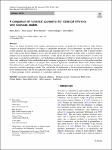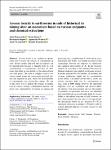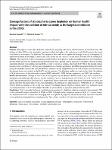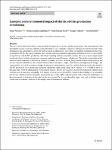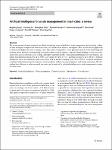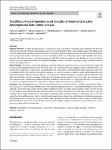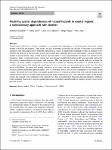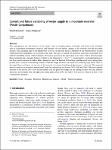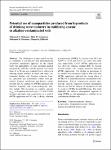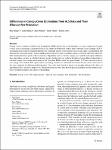Search
Author
- Osman, Ahmed I. (5)
- Daqing, Ma (3)
- Jorgensen, Ed (3)
- Li, Yan (3)
- next >
Subject
- kinh tế (26)
- Economics (12)
- programming (10)
- XRD (10)
- next >
Date issued
- 2020 - 2025 (2128)
- 2010 - 2019 (129)
- 2000 - 2009 (9)
- 1999 - 1999 (1)
Has File(s)
Search Results
Due to our limited knowledge about complex environmental systems, our predictions of their behavior under different scenarios or decision alternatives are subject to considerable uncertainty. As this uncertainty can often be relevant for societal decisions, the consideration, quantification and communication of it is very important. Due to internal stochasticity, often poorly known influence factors, and only partly known mechanisms, in many cases, a stochastic model is needed to get an adequate description of uncertainty. As this implies the need to infer constant parameters, as well as the time-course of stochastic model states, a very high-dimensional inference problem for model calibration has to be solved. |
Eisenia fetida is an earthworm species often used to assess the toxicity of contaminants in soils. Several studies indicated that its response can be unpredictable because it depends both on total concentrations of contaminants and also on their forms that differ in susceptibility to be released from soil solid phase. The issue is complex because two various uptake routes are concurrently involved, dermal and ingestion in guts, where the bioavailability of contaminants can considerably change. The aim of this study was to analyze the toxicity of arsenic (As) in various strongly contaminated meadow and forest soils, representative for former As mining and processing area, to earthworms E. fetida and its accumulation in their bodies. |
Stratospheric ozone (O3) depletion caused by O3-depleting substances (ODSs) remains an unsolved issue. The leakage of older ODSs in the atmosphere continue to affect stratospheric O3, and nitrous oxide (N2O) remains the largest contributor to stratospheric O3 depletion. The purpose of this study was to update the damage factors of stratospheric O3 depletion on human health impacts, particularly skin cancers and eye cataracts, for the years 2010 and 2015 by adding N2O. |
The use of fossil fuel-based vehicles may gradually be replaced by electric vehicles in the future. The trend indicates that the number of users of electric vehicles, especially electric cars, continues to increase. Indonesia is well-positioned to take advantage of this opportunity as it has the world’s largest nickel reserves, an essential raw material for making electric vehicle batteries (EVB). The study examines the economic and environmental implications if Indonesia were to successfully set up electric vehicle (EV) production rather than exporting such raw materials overseas. |
The rising amount of waste generated worldwide is inducing issues of pollution, waste management, and recycling, calling for new strategies to improve the waste ecosystem, such as the use of artificial intelligence. Here, we review the application of artificial intelligence in waste-to-energy, smart bins, waste-sorting robots, waste generation models, waste monitoring and tracking, plastic pyrolysis, distinguishing fossil and modern materials, logistics, disposal, illegal dumping, resource recovery, smart cities, process efficiency, cost savings, and improving public health. |
As litter decomposition is a fundamental process in forest ecosystems, representing the link between aboveground and belowground biogeochemical processes, we developed an effect size summarisation of the implications of forest management on litter decomposition rate, by applying a multi-level meta-analysis and multivariate mixed-effects meta-analytic linear models. Our aim was to review the findings of the current literature and to understand how forest management, silvicultural treatment, and forest operations could affect litter decomposition rate. Furthermore, we investigated the effects of environmental variables that included stand type, climatic conditions, and the percentage of biomass removal on litter decomposition rate. |
Natural hazards like floods, cyclones, earthquakes, or, tsunamis have deep impacts on the environment and society causing damage to both life and property. These events can cause widespread destruction and can lead to long-term socio-economic disruption often affecting the most vulnerable populations in society. Computational modeling provides an essential tool to estimate the damage by incorporating spatial uncertainties and examining global risk assessments. Classical stationary models in spatial statistics often assume isotropy and stationarity. It causes inappropriate smoothing over features having boundaries, holes, or physical barriers. Despite this, nonstationary models like barrier model have been little explored in the context of natural disasters in complex land structures... |
This study presents the characteristics of the current course of the phenomenon of droughts and floods in the catchment area of a man-made mountainous reservoir and forecasts of water inflow changes to the reservoir over the next three decades. The catchment area of the Klimkówka reservoir on the Ropa River, a tributary of the Wisłoka River, located within the Polish Carpathians was selected for the study. The analysis carried out, using Soil and Water Assessment Tool (SWAT) modelling among other techniques, showed an increase in the importance of low-flow outflow from the upper Ropa catchment and a negative balance of inflow to the reservoir (Q < 2 m3 s−1), manifested by a prolonged duration of low flows and an increase in outflow deficit during the year. |
The stabilization of heavy metals in soils is considered a cost-effective and environmentally sustainable remediation approach. In the current study, the applicability of water treatment residual nanoparticles (nWTRs) with the particle size ranged from 45 to 96 nm was evaluated for its efficacy in reducing arsenic mobility in clayey and sandy contaminated alkaline soils. Sorption isotherms, kinetics, speciation and fractionation studies were performed. Sorption equilibrium and kinetics studies revealed that As sorption by nWTRs-amended soils followed Langmuir and second-order/power function models. |
Canopy cover is a primary attribute used in empirical wildfire models for certain fuel types. Accurate estimation of canopy cover is a key to ensuring accurate prediction of fire spread and behaviour in these fuels. Airborne Laser Scanning (ALS) is a promising active remote sensing technology for estimating canopy cover in natural ecosystems since it can penetrate and measure the vegetation canopy. Various methods have been developed to estimate canopy cover from ALS data. However, little attention has been given to the evaluation of algorithms used to calculate canopy cover and the subsequent influence these algorithms can have on wildfire behaviour models. |

